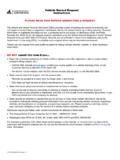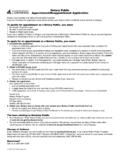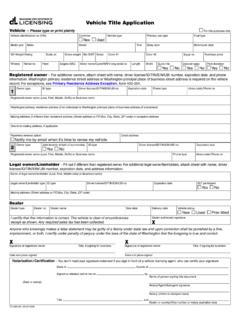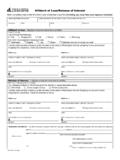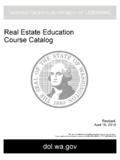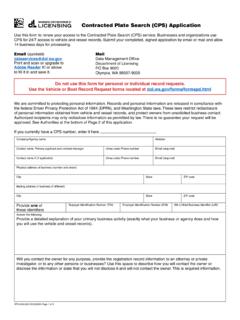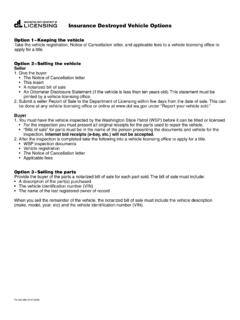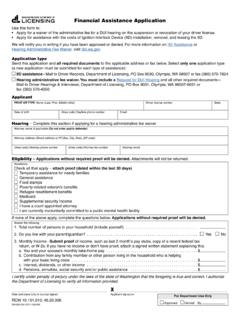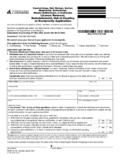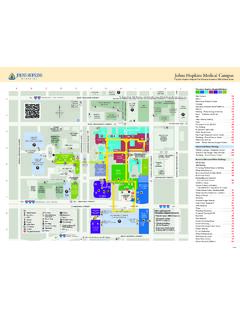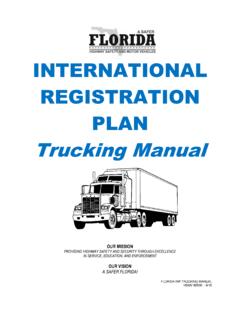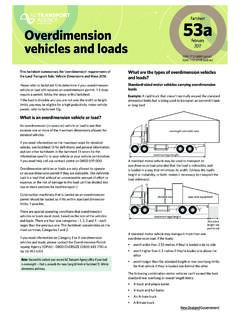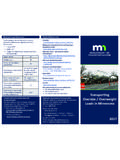Transcription of Preface – CDL
1 Preface CDL i Preface CDL ii This Commercial Driver License (CDL) Guide is a summary of the laws and rules that apply to all drivers of commercial motor vehicles in Washington State. It is not a book of laws, and should not be used as a basis for any legal claims or actions. Regulations put into effect by federal or state agencies may go beyond state laws but cannot conflict with them. We welcome your comments and suggestions. Send them to: Communications and Education Department of Licensing 1125 Washington Street SE Olympia WA 98501 For your convenience, additional contact information is given below. Department of Licensing (DOL) Website: For information about driving records,reinstatements, and eligibility. Telephone:(360)902- 3900 For vehicle questions:Prorate (IRP) .. (360) 664-1858 (360) 664-1858 Federal Motor Carriers SafetyAdministration (FMCSA) Telephone: (360) 753-9875 Website: Hours of service Equipment Interstate medical waivers Federal rules and regulationsTransportation Security Administration (TSA) Telephone: (855) 347-8371 Website: Hazmat endorsement eligibility Threat assessments Background checks FingerprintsWashington State Patrol (WSP) Telephone: (360) 596-3800 Website: Enforcement practices Weight enforcementWashington Utilities and Transportation Commission (WUTC) Telephone: (360) 664-1222 Website: Authority to carry freight for hire Intrastate inspectionsWashington State Department of Transportation (WSDOT) Telephone: (360) 705-7000 / (360) 705-7438 Website: Interpretation of statutes or rules Restricted roads or bridges oversize /Overweight permits Construction projectsHazardous Material National Response Center (NRC) Telephone.
2 1-(800) 424-8802 To report a hazardous material emergency Chemical Transportation Emergency Center (CHEMTREC) Telephone: 1-(800) 424-9300 For technical information about physical properties of hazardous materials We are committed to providing equal access to our services. For information visit (TDD/TTY call 711). Preface CDL iii Table of Contents Introduction You Must Have a CDL to Operate ..1-1 Commercial Learners Requirements ..1-3 Commercial Driver License Tests ..1-8 Medical Documentation Requirements ..1-11 CDL Disqualifications ..1-13 Hazardous Material Endorsement ..1- 15 Traffic 15 Other CDL 15 International Registration Plan/International Fuel Tax Agreement ..1- 16 Washington State Laws and Rules.
3 1- 18 Driving Safely vehicle Inspection ..2-1 Basic Control of Your Shifting Gears ..2-9 Seeing ..2-10 Communicating ..2-11 Controlling Managing Space ..2-16 Seeing Distracted 21 Aggressive Drivers/Road 23 Driving at 24 Driving in Fog ..2- 27 Driving in 27 Driving in Very Hot 29 Railroad-highway Crossings ..2- 30 Mountain Driving ..2-32 Table of Contents Page TOC-1 Driving Emergencies ..2- 33 Antilock Braking Systems (ABS ..2- 35 Skid Control and Recovery ..2- 36 Accident Procedures ..2- 38 38 Alcohol, Other Drugs, and 40 Hazardous Materials Rule For All Commercial 42 Transporting Cargo Safely Inspecting Cargo ..3-1 Weight and Balance ..3-1 Securing Cargo ..3-2 Cargo Needing Special Attention.)
4 3-3 Transporting Passengers Safely vehicle Inspection ..4-1 Loading and Trip On the Road ..4-2 After-trip vehicle Inspection ..4-3 Prohibited Practices ..4-3 Use of Brake-door Air Brakes The Parts of an Air Brake Dual Air Brake ..5-5 Inspecting Air Brake Systems ..5-6 Using Air Combination Vehicles Driving Combination Vehicles Safely ..6-1 Combination vehicle Air Antilock Brake Table of Contents Page TOC-2 Coupling and Uncoupling ..6-7 Inspecting a Combination 13 Doubles and Triples Pulling Double/Triple Trailers ..7-1 Coupling and Uncoupling ..7-1 Inspecting Doubles and Doubles/Triples Air Brake Check ..7-4 Tank Vehicles Inspecting Tank Driving Tank Safe Driving Hazardous Materials The Intent of the Regulations.
5 9-2 Hazardous Materials Transportation-Who Does What ..9-2 Communication Rules ..9-3 Loading and Unloading ..9- 10 Bulk Packaging Marking, Loading and 12 Hazardous Materials- Driving and Parking Rules ..9- 13 Hazardous Material Emergencies ..9- 15 Hazardous Materials Glossary ..9- 19 School Buses Danger Zones and Use of Loading and Unloading ..10-3 Emergency Exit and Railroad-highway Crossings ..10-7 Student Antilock Braking Systems ..10-10 Special Safety Table of Contents Page TOC-3 Skills Test Overview Overview of the CDL Skills Test ..11-1 General Test vehicle Inspection Test ..11-2 Equipment Failure ..11-4 External/Internal Inspection (All Vehicles)..11-5 External Inspection (All Vehicles) ..11-9 Trailer ..11-13 Passenger Vehicles (School Bus and Coach/Transit).
6 11-14 Coach/Transit ..11-15 Remainder of Taking the CDL vehicle Inspection Test ..11-15 Grounds for Automatic Disqualification ..11-15 Basic vehicle Control Skills Test Overview of the CDL Skills Test ..12-1 Test Rules ..12-1 Scoring ..12-3 Grounds for Automatic On-Road Driving Overview of the CDL Skills Test ..13-1 General Test How You Will Be Table of Contents Page TOC-4 Section 1 INTRODUCTION This Section Covers Medical Requirements Driver Disqualifications Other Safety Rules International Registration Program Nationwide CDL Rules Washington State Laws and Rules The Commercial Motor vehicle Safety Act of 1986 requires all states to meet the same minimum standards for testing and licensing commercial drivers. This manual provides driver license testing information for drivers who wish to have a commercial driver license (CDL).
7 This manual does NOT provide information on all the federal and state requirements needed before you can drive a commercial motor vehicle (CMV). Contact the Department of Licensing for additional information ( ). - You must have a CDL to operate: Any single vehicle with a gross vehicle weight rating (GVWR) of 26,001 pounds or more. A combination vehicle with a gross combination weight rating (GCWR) of 26,001 or more pounds, provided the GVWR of the vehicle (s) being towed is in excess of 10,000 pounds. A vehicle designed to transport 16 or more passengers (including the driver). All school buses regardless of size. Any size vehicle which requires hazardous material placards or is carrying material listed as a select agent or toxin in 42 CFR part 73. Federal regulations through the Department of Homeland Security require a background check and fingerprinting for the Hazardous Materials endorsement. To get a CDL, you must pass knowledge and skills tests.
8 All applicants must wait 24 hours after passing a CDL skills test before visiting a Licensing Service Office to have their CDL issued. This manual will help you pass the tests, however, it is not a substitute for a truck driver training class or program. Formal training is the most reliable way to learn the many special skills required for safely driving a large commercial vehicle and becoming a professional driver in the trucking industry. Figure helps you determine if you need a CDL. -ExemptionsThe law exempts four groups of drivers from the CDL: Farmers transporting farm equipment, supplies, or products to or from a farm in a farm vehicle are exempted if the vehicle is: Operated by a farmer or a farm employee. Not used in the operation of a common or contract motor carrier. Used within 150 miles of the farm (in an air-mile radius). Products include Christmas trees or wood products transported by vehicles weighing no more than forty thousand pounds licensed gross vehicle weight.
9 The weight restriction applies only to Christmas trees and wood products. Farmers may operate vehicles that meet the definition of a farm-exempt vehicle between the states of Idaho and Oregon if they meet all requirements of the farm exemption. Firefighters and law enforcement personnel operating emergency equipment are exempted if they carry the certification card proving they have completed the Emergency vehicle Accident Prevention (EVAP) or Emergency vehicle Incident Prevention (EVIP) Programs. Recreational vehicle (RV) operators are exempted when driving an RV for non-commercial purposes. This group includes: Two-axle rental trucks. Horse trailers. Military commercial drivers are exempted only when they are operating the proper military vehicles under a military license issued by their branch of service. Section 1 Introduction Page 1-1 Figure Determining Class of CDL Required Note: A bus may be Class A, B, or C depending on whether the GVWR is over 26,001 pounds or is a combination vehicle .
10 Application To get a Washington Commercial Driver License (CDL) or a Commercial Learners Permit (CLP) you must: 1. Be at least 18 years old. 2. Have a valid Washington State driver license. 3. Provide your valid Social Security number issued by the Social Security Administration. 4. Provide Lawful Permanent Residency 5. Provide the names of all the states where you have had a driver license in the last ten years. 6. Self-certify what type of commercial commerce you expect to operate. 7. Pass all applicable knowledge tests for the vehicle class and type you intend to operate. 8. Pay the proper fees. The CLP is valid for 180 days and may only be renewed one time. Visit for more information on CDL knowledge, skills testing, and license issuance fees. To get a CDL you must also successfully complete: All required knowledge tests, including applicable skills tests. If you are getting your first CDL, or you have not been commercially licensed for the last year, you must provide proof of completing a commercial driver training program per the mandatory training requirements from a Washington State approved training school or registered employer.
